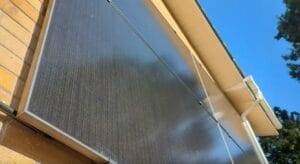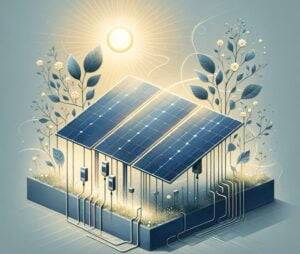Guide on strategic decision-making on investment in solar energy for usage with heat pumps. Enhancing electrical infrastructure, and planning for future energy efficiency.

As the world shifts from fossil fuels to renewable energy, homeowners increasingly explore ways to make their homes more energy-efficient and sustainable. The UK government actively encourages this transition by offering a £7,500 grant for new heat pump installations. These heat pumps run on electricity, making them a perfect match for solar power systems.
In this article, we’ll explore how combining solar panels and heat pumps can be a strategic investment for your home, providing a hedge against future electricity price hikes when alternative energy sources like gas are no longer as widespread.
Are Heat Pumps Compatible with Solar Panels?
Yes, heat pumps and solar panels make an excellent team. Heat pumps run on electricity, extracting heat from the air, ground, or water to heat your home. This means they can be powered by the electricity generated by your solar panels. Pairing a heat pump with a solar panel system can significantly reduce your reliance on the grid, leading to substantial savings on your energy bills.
Is a Heat Pump Worth It with Solar?
Absolutely. A heat pump can be a worthwhile investment when paired with solar panels for several reasons:
- Energy Efficiency: Heat pumps are incredibly efficient, often providing up to three times the amount of electrical energy they consume in heat energy. This efficiency can lead to significant cost savings when powered by solar panels.
- Financial Incentives: The UK government is offering a £7,500 grant for new heat pump installations. This financial incentive can help offset the cost of the heat pump, leaving only the initial investment in the solar panel system to be funded by you. The good news is that this system can be built incrementally.
- Future-Proofing: With the ongoing shift towards renewable energy, investing in a solar panel and heat pump system can protect you against future electricity price increases.
Can You Run a Heating System with Home Solar?
Yes, solar energy can be used to run a heating system. Solar panels convert sunlight into electricity, powering electric heating systems, including heat pumps. This can significantly reduce your reliance on fossil fuels for heating, leading to lower energy bills and a smaller carbon footprint.
If you are planning to transition to a heat pump, installing a home solar energy system should be front of your mind. To make the case even more compelling you can recoup your investment even quicker by selling excess energy to your utility company in the spring, summer and early autumn.
The Smart Export Guarantee
There’s another reason why installing a solar panel and heat pump system is a strategic investment. Home solar systems have access to a government backed scheme for selling renewable energy to the gride called the Smart Export Guarantee (SEG). Traditionally, only MCS-certified installations were eligible for this scheme.
Recently Octopus Energy started a trial where non-MCS-certified systems can apply for SEG. Octopus Energy’s trial opens up this opportunity to systems installed by a combination of DIY and electrician contractors. This can help improve the return on investment for your system, as MCS installations can be more expensive.
Is Using Solar and Heat Pump Viable With the UK Weather?
Relying solely on solar power for heating during the winter months can be challenging, particularly in regions with shorter daylight hours and frequent cloud cover. For instance, a 10kWp solar panel system in the UK can generate around 8,500 kWh annually, but the distribution of this generation is not even throughout the year. The output can drop significantly in winter due to fewer daylight hours and increased cloud cover. For instance, in December, such a system might only produce around 300 kWh, compared to approximately 1,000 kWh in July.

However, this doesn’t mean solar power is unfeasible in winter. It simply means homeowners need to have contingencies in place. These could include:
- Energy-efficient home improvements to reduce overall energy demand
- A well-insulated hot water tank to store excess heat.
- Battery storage system to store surplus energy generated during sunnier periods.
Retaining a hybrid power supply system combining solar power with a grid connection is a reasonable contingency. At the same time, investing in reducing your home’s energy consumption is a viable way to minimising the reliance on that contingency.
There are examples of entirely off-grid solutions too. For instance, the Passivhaus standard created in Germany for buildings designed to be ultra-energy efficient combines solar power with a heat pump and excellent insulation to stay warm even in the harshest winters. This demonstrates that solar power can be a viable heating solution year-round with the right planning and contingencies.
Can You Run a Heat Pump on a Battery?
Absolutely. Running a heat pump from home battery storage can be an effective way to maximise the use of your solar energy and reduce reliance on the grid. Home solar batteries can store excess energy generated by your solar panels during the day, which can then be used to power your heat pump at night or during periods of low sunlight.
Introducing flexible energy tariffs in the equation, you can charge your battery with cheaper electricity during off-peak hours and use that stored energy during peak times. This strategy can significantly reduce your energy costs and increase the overall efficiency of your system.
The cost of battery storage is also trending downward, making it an increasingly affordable option for homeowners. For instance, a 30kWh battery storage system, which can provide ample power for a heat pump, can now be built for less than £6,000.
This combination of solar panels, a heat pump, and a battery storage system can create a highly efficient, cost-effective, and sustainable heating solution for your home. It allows you to harness the sun’s power, store it efficiently, and use it when needed, ensuring a warm and comfortable home even during the coldest winter months.
Strategic Investments for Transitioning to Heat Pumps and Solar
As we move towards a more sustainable future, making strategic investments in your home’s heating system can pave the way for a smooth transition to heat pumps and solar energy. Here are some steps you can consider:
Upgrade Your Open Vented System to a Sealed System
Many homes in the UK still operate open-vented heating systems, those were so prominent that are also known as conventional, and were still being built through the 1980s. These systems have done their service and there is no need for them to stay around much longer. Upgrading to a sealed system with expansion tanks can offer several benefits. Sealed systems are more efficient, less prone to airlocks, corrosion and sludge build-up, and offer greater flexibility regarding boiler and component location.
So if you find yourself considering a replacement for this system, the best option is to go for a sealed system and keep your water tank and not go for a combi boiler. Sealed water tanks are compatible with heat pumps, and you will be saving on having to retrofit.
Invest in Underfloor Heating or Larger Radiators
Heat pumps operate more efficiently at lower temperatures than traditional boilers. Therefore, upgrading to underfloor heating or larger radiators can allow for more effective heat distribution at these lower temperatures. Underfloor heating provides the most comfortable form of heat and saves wall space as no radiators are needed. The best option is water underfloor heating. These operate at temperatures around 30-40°, which fits perfectly with the water temperature produced by heat pumps.
Install a Consumer Unit with Extra Space
As you plan to integrate a heat pump and solar energy system, it’s wise to consider your home’s electrical infrastructure. Suppose you are about to modernise or replace a consumer unit. In that case, consider installing a unit with extra spaces so you can later accommodate the additional circuit breakers and safety devices required for these systems.
Consider a Separate Consumer Unit in Your Garage
If you plan to install solar panels on your garage roof, it might be worth installing a separate consumer unit in the garage. This avoids overloading the circuits in your house and provides a dedicated space for the solar system’s electrical components.
Plan for Future Inverter and Battery Placement
When installing a new consumer unit, consider its proximity to a suitable location for an inverter and batteries. These components are crucial for a solar energy system and having them close to the consumer unit can simplify the installation and reduce wiring costs.
By making these strategic investments, you can prepare your home for the transition to a heat pump and solar energy system. Not only will these upgrades enhance your home’s energy efficiency, but they can also increase your comfort and potentially add value to your property.
Conclusion
Investing in solar energy and a heat pump system is a strategic move for homeowners. It can lead to significant energy savings and allow you to take advantage of government incentives and innovative schemes like the Octopus Energy trial. By making this investment, you’re not just future-proofing your home against rising energy costs but also contributing to the global shift towards renewable energy.









